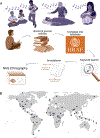Universality and diversity in human song
- PMID: 31753969
- PMCID: PMC7001657
- DOI: 10.1126/science.aax0868
Universality and diversity in human song
Abstract
What is universal about music, and what varies? We built a corpus of ethnographic text on musical behavior from a representative sample of the world's societies, as well as a discography of audio recordings. The ethnographic corpus reveals that music (including songs with words) appears in every society observed; that music varies along three dimensions (formality, arousal, religiosity), more within societies than across them; and that music is associated with certain behavioral contexts such as infant care, healing, dance, and love. The discography-analyzed through machine summaries, amateur and expert listener ratings, and manual transcriptions-reveals that acoustic features of songs predict their primary behavioral context; that tonality is widespread, perhaps universal; that music varies in rhythmic and melodic complexity; and that elements of melodies and rhythms found worldwide follow power laws.
Copyright © 2019, American Association for the Advancement of Science.
Conflict of interest statement
Figures








Comment in
-
The world in a song.Science. 2019 Nov 22;366(6468):944-945. doi: 10.1126/science.aay2214. Science. 2019. PMID: 31753980 No abstract available.
References
-
- Longfellow HW, Outre-mer: A pilgrimage beyond the sea (Harper, 1835).
-
- Bernstein L, The unanswered question: Six talks at Harvard (Harvard University Press, Cambridge, Mass, 2002).
-
- Mehr SA, Krasnow MM, Parent-offspring conflict and the evolution of infant-directed song. Evol. Hum. Behav 38, 674–684 (2017).
-
- Hagen EH, Bryant GA, Music and dance as a coalition signaling system. Hum. Nat 14, 21–51 (2003). - PubMed
Publication types
MeSH terms
Grants and funding
LinkOut - more resources
Full Text Sources
Miscellaneous

